Contribute
| Dance Saturdays: RASA-An Exploration Of Classical Indian Dance |
Geetha Patil
03/21/2019
The José Mateo Ballet Theatre’s Dance for World Community presented a breathtaking dance program as its first episode of the stage for a new dance series known as Dance Saturdays at Sanctuary Theatre, Cambridge, MA on Saturday, Mar 16, 2019, from7:00pm - 10:00pm. The Dance Saturdays program is showcasing local, culturally diverse dance groups along with music, visual arts, and food for an immersive dance celebration. Hundreds of audiences attended the program RASA-An exploration of Classical Indian Dance with much enthusiasm to learn more about the Indian classical dances and music and enjoyed them with much appreciation and gratitude. Performances by local Indian artists including the Vidyanjali Dancers of New England, the Hindu Temple Rhythms, the Upasana Odissi, Mr. Shekhar Shastri of Meru Foundation, Poet and Lyricist Smt. Sunayana Kachroo, the artists of Kalakruti and more were put together with the title RASA. RASA in the Sanskrit text, denotes the essential quality in dance and other arts that transports audiences to another reality full of wonder to inspire a heightened consciousness. This RASA team presented the delight and the mystery of two of India's ancient Classical dance forms: Bharatanatyam and Odissi. Both are influenced and enhanced by the history, literature, music and visual art of multicultural India. The Dance Saturdays’ RASA program started with the welcome note by Shri. José Mateo, the Founder and Director of José Mateo Ballet Theatre and presided over by world-renowned dance guru 'Natya Veda Bharati' Smt. Sudha Chandra Sekhar. She was also the guest of honor. Smt. Sudha Chandra Sekhar (nattuvangam), shri. Aditya Venkatesh (vocals), Shri. Varun Chandramouli (mridangam), and Shri. Kiran Manda (violin) presented a very melodious invocation song (Ragam: Hamsadhwani, Thalam: Adi) followed by Shri Ganapati song by Anandini Chandra Sekhar (Ragam: Hamsadhwani, Shanmukhapriya, Devamanohari/Darbar, Thalam: Adi) with Kavuthwams - ancient beautiful temple dances. The next dance item was the Alarippu, a traditional invocation dance in the Bharata Natyam repertoire. Alarippu means ‘blossoming’ and in this dance we saw the dancers’ limbs unfold like the petals of a blooming flower. For this dance, Smt. Anandini Chandra Sekhar sang song in Ragam: Nattai, Thalam: Thisram. Shri. Shekhar Shastri, the Master of Ceremony, introduced Smt. Amrutha Ananth who presented Padam: Ananda Nadamidum Padam dance as a Worship/Spirituality and Praise for Lord Shiva with the song sung by her husband, Shri Aditya Venkatesh in Ragam: Kedaragowlai, Thalam: Adi. Smt. Divya Narayan, and Smt. Chitra Narayan displayed their dance - Padam: Devi Neeye Thunai for the lyrical poem by the Tamil poet Papanasam Sivan, which extols the warrior-goddess Meenakshi, sung by Smt. Kavitha Venkatesan in Ragam: Keervani, Thalam: Adi. In the Poetry and Literature Segment, Shri. Shastri described how the poetry and literature of India have influenced the dance art. Smt. Sunayana Kachroo read her Hindi poem titled Panni (Water) and Shri. Sam Bhambhani played guitar and the dancers Smt. Anandini Chandra Sekhar, Smt. Mouli Pal danced and demonstrated every word of the poem through their dance postures. Smt. Kachroo also presented a Rap song that involved both dancing and clapping by the audiences. Shri. Shekhar Shastri recounted to the audience the Visual Art, Sculpture, and Architecture and their influence on Dance. He also provided a brief introduction to Odissi dance and Smt. Mouli Pal who presented two elegant solo Odissi dances Pallavi (Raag: Miya Mallhar Taal: Ektaali) and Abhinaya - Maare Baano. Abhinaya is a mime where the dancer vividly depicted a song or poem and expressed its mood and meaning using an intricate language composed of facial expressions, hand gestures and body movements. She used recorded music with music composition by Debasish Sarkar, Rhythm Composition by Uttam Mondol. This was followed by the introduction of Smt. Sudha ji and her Abhinaya to the audiences as the master of the Art and the carrying on of Tradition very diligently and nurturing it with much care and concern. Smt. Sudha Ji (as nattuvangam - who coordinates the dancers and musicians) and her team presented the live teaching of Abhinaya through the demonstration of Krishna Nee Begane Baroo song sung by Smt. Kavitha Venkatesan in Ragam: Yamuna Kalyani, Thalam: Misra Chapu. All these dancers presented their dance with an excellent aesthetic effect. Then came the interactive segment on music and rhythm by Rohith Jayaraman of Berklee Indian Ensemble fame. He talked about the Kunnakol (the art of performing percussion syllables vocally in South Indian Carnatic music), Jathi (specifies beat count of the rhythm cycle), Sollakattu (a combination of konnakol syllables spoken while simultaneously counting the tala that is clapping with the hand) and Rhythms in Indian Classical Music for Dance. He said that Hindustani and Carnatic music have the same names of the ragas but the way they are performed is different. Audiences also enjoyed leaning some talas from Rohit and clapped very actively and keenly while he was signing. First and foremost, Shri. Shastri Ji thanked very sincerely Shri. José Mateo for including and supporting the local Classical Indian Dance groups in their Dance Saturdays series. He thanked profusely all the performers for their wonderful performances. He also thanked local artists for displaying their art work in the hall way with help of Smt. Catherine Amidon the Exhibition Curator. He also thanked the sound engineer Shri Javed Ji. He also thanked from the bottom of his heart all the audiences for their generous support and keen interest in learning and enjoying dances and music from other cultures. Shri José Mateo thanked abundantly his team Shri. Shekhar Shastri, Smt. Anandini Chandra Sekhar, and Smt. Sudha Chandra Sekhar for putting this program together very nicely. Smt. Anandini Chandra Sekhar and Shri Manteo thanked their volunteers for their time and loyal services.
The finale dance item presented a beautiful composition of Pandit Ravi Shankar known as Tarana - a Hindustani classical piece that used syllables that emulate the sitar and tabla. This piece was created by Mouli and Anandini that showed the contrast between Bharatanatyam and Odissi placed side by side, but simultaneously showcased their similarities.
You may also access this article through our web-site http://www.lokvani.com/



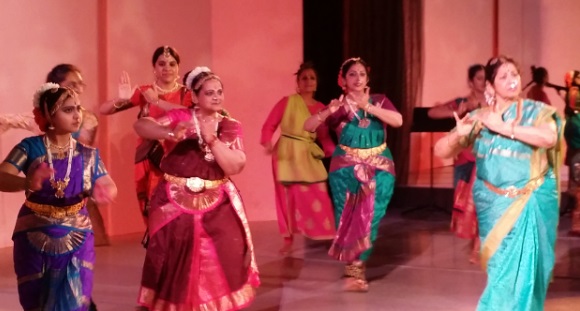
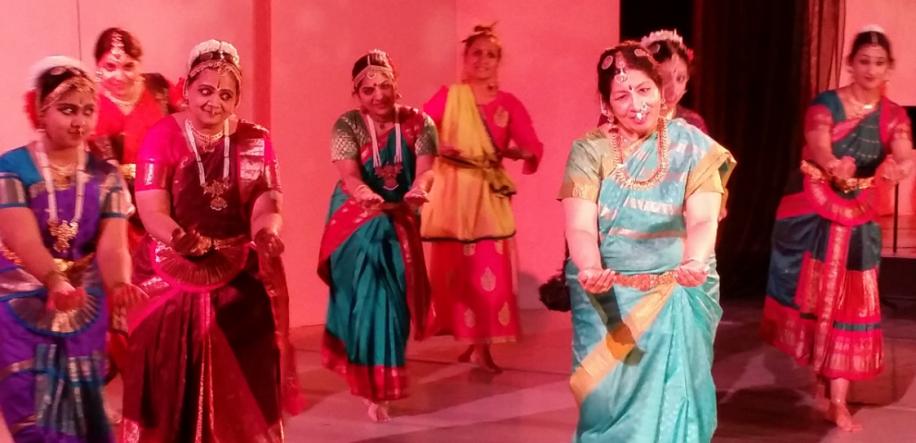
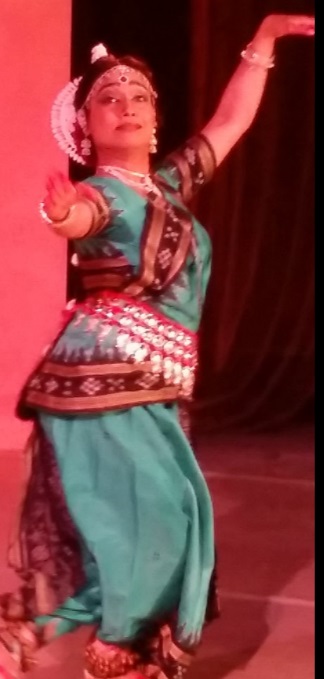
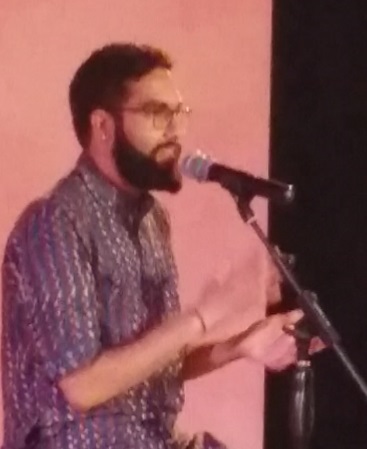
.jpg)

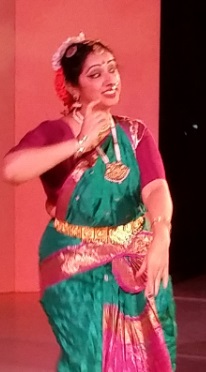
_1.jpg)
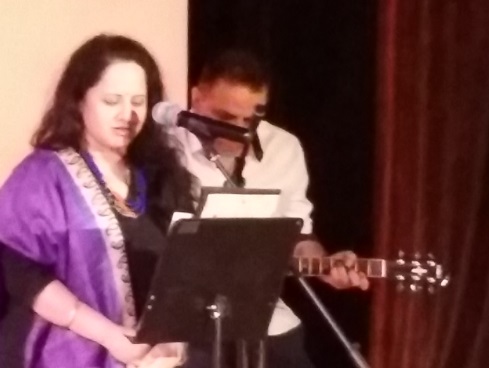
andShri.SamBhambhaniplayedguitarandthedancersSmt.AnandiniChandraSekhar,Smt.MouliPaldancingtothetuneofthepoem.jpg)
andShri.SamBhambhaniplayedguitarandthedancersSmt.AnandiniChandraSekhar,Smt.MouliPaldancingtothetuneofthepoem_1.jpg)
andShri.SamBhambhaniplayedguitarandthedancersSmt.AnandiniChandraSekhar,Smt.MouliPaldancingtothetuneofthepoem_2.jpg)